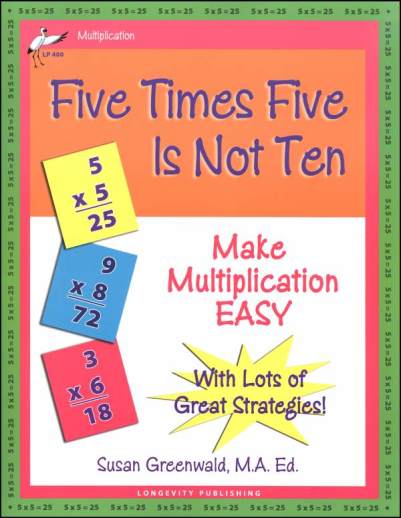We use cookies to make your experience better. To comply with the new e-Privacy directive, we need to ask for your consent to set the cookies. Learn more.
Five Times Five Is Not Ten: Make Multiplication Easy
Multiplication facts should be committed to memory for immediate recall during timed tests and to succeed at higher math levels. There are enough new concepts to assimilate at the high school level without being hindered by inadequate retention of the basic math facts. These will also be used continuously in real-life applications. Whether a student is just beginning to learn the multiplication facts or needs a little more help to totally master them, this book can help.
Similar to Two Plus Two is Not Five (for addition and subtraction), this volume presents multiplication facts incrementally, using mastery strategies. As in that book, strategies are meant to bridge the way between counting and memorization, not as a substitute for instant recall. There are 33 sets of strategy introductions, followed by practice, review, and cumulative review pages a total of 148 reproducible pages in all. The Guide to Introducing the Facts supplies helpful terminology and instructions for each introduction. Facts are not introduced in order; they are introduced by strategy, with easier strategies (like doubles) near the beginning. You will probably want to use a set of multiplication flash cards for daily drill and practice of presented facts to use in tandem with this book. The Guide lists facts to add to your flash card drill with each introduction. As facts are presented, students can check them off on their Record-Keeping Checklists. As they are mastered, they can be circled on the Math Facts Baseline Recorder. This sheet of the 81 multiplication facts can also be used for remedial students as a starting point for instruction. Practice pages of facts contain both vertical and horizontal format problems and sometimes include a few addition and/or subtraction facts for review. This keeps children on their toes so they remember to look at the sign of a problem before working. There are also cumulative review pages that review all facts introduced to that point. Some of these (listed in introduction) are meant to be used for testing and timed drills to determine mastery. Children should only answer the ones they know from memory, without counting; others should be left blank. Other Review pages are used for reinforcement of particular strategies and math facts. Many of these are concentrated toward the back of the book as a final review. You will probably use these only if your child has not demonstrated mastery of those facts yet. The pages are easy on the eye; very clean and clear-looking with problems nicely spaced. This one looks like a good bet for nailing those multiplication facts once and for all.
| Product Format: | Softcover Book |
|---|---|
| Brand: | Longevity Publishing |
| Author: | Susan Greenwald |
| Grades: | 3-6 |
| ISBN: | 9780977732319 |
| Length in Inches: | 8.5 |
| Width in Inches: | 11 |
| Height in Inches: | 0.37 |
| Weight in Pounds: | 0.9 |

